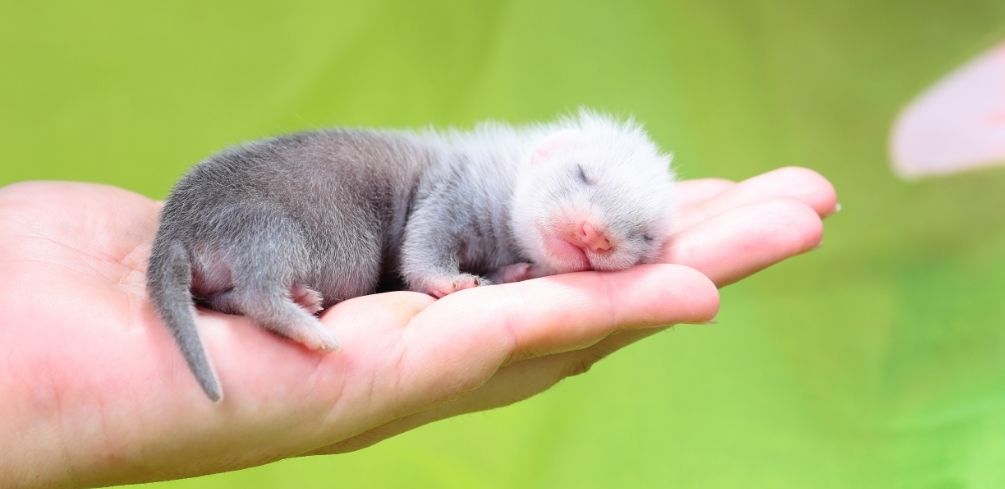Ferrets care for their young by nursing them every couple of hours and letting them sleep for the first three weeks. Kits are completely reliant on their mother, to the point where they require her gentle cleaning after defecating to maintain their health and well-being.
When the kits are born, they are only 2 inches in length and completely reliant on their mother for survival. Their eyes and ears are covered in a fuzz of wispy fur, and they have no way of seeing or hearing.
You can handle the kits when they are one week old, but keep in mind that they are reliant on their mother, who will let you know as soon as she is not pleased with your actions.
How Are New-Born Ferrets Like
At the beginning of their lives, kits are completely helpless and reliant on their mothers for their survival. Their eyes and ears have been sealed shut, causing them to be blind and deaf as a result.
Each of the kit’s tiny bodies, which are no larger than a standard lipstick tube, is covered in a thin layer of fuzz. The majority of kits are born without any teeth, though baby incisors are usually visible by day ten.
How Ferrets Take Care of Their Young
Kits remain in their burrow with their mother for approximately 6 weeks after birth. When the autumn season arrives, the young ferrets leave their mother and learn to be self-sufficient.
By the time they are a year old, they are mature enough to have their own nest.
The First 3 Weeks
Kittens who have reached the age of three weeks are working hard to quickly develop their nest legs while they bravely explore their surroundings. Their mother is still present, keeping a close eye on the young ones in case they get too far away from the nest.
Natural weaning should begin at this age, even though the kits still rely on their mother for the majority of their nourishment. Some baby premolars as well as some baby canine teeth are beginning to erupt, and permanent incisor teeth are breaking through and pushing the baby incisors out of the way.
Week 4
The fourth week is somewhat of a turning point in a kit’s new life. His eyes and ears begin to show signs of opening up to the world.
His soft, white fuzz should start taking on some color and pattern, giving you a glimpse into his future.
More baby premolars also start to erupt around this time. Healthy kits should be eager to dive into the bowl of soft mush you provide and stuff themselves while still taking advantage of mom’s milk supply.
And although mom may still want to remind the kits to go to the bathroom, the kits should show signs of being the self-proficient poopers that their parents are.
How Do Mother Ferret Train Kits for Potty Habits
Kits start to explore their nest a little bit and begin to develop the small muscles in their legs as a result. They can distinguish between their mother and siblings based on their smell.
During the first few weeks, however, the young kits require stimulation to go to the bathroom, which is provided by mama fuzzy.
The smell of their mother’s potty habits carries them around the cage even before their eyes are open, and they follow her around when she goes to the bathroom.
It is extremely endearing to see a small kitten with eyes closed but still performing the corner potty pose. They have the most priceless expressions on their little faces when they realize what they have done.
Week 5
By week five, a kit’s eyes and ears have opened and he’s ready to get into trouble! Kits at this age are extremely active and are starting to rough and tumble with their siblings.
During this stage of development, kits are extremely active and begin to play rough and tumble with their older siblings.
Week 6
By the sixth week, the kits should be eating more soft food and relying less and less on their mother for nutritional support. At this age, some breeders administer the dreaded first distemper vaccination, which is a source of great concern.
By week six, the kits should start eating more soft food and start relying less and less on mom for nutritional support. Some breeders introduce the dreaded first distemper vaccination at this age.
Do Ferrets Eat Their Young
Ferrets can eat their kits if they sense danger. If the mother isn’t happy with how you’re handling her babies at first, try again at a later time because you don’t want her to start eating her babies.
How Can You Take Kits from Their Mother
Initially, kits are small enough to fit in the palm of your hand. Picking them up with one hand should be done gently, between the neck and shoulders, while the other hand supports their hind legs as they grow older.
Begin by holding the kits for a few seconds, and gradually increase this time to a few minutes as they grow in maturity. If, on the other hand, the kits are feeding, do not interrupt their feeding to handle them.
What Do Kits Need
The only things that healthy newborn kits care about are getting food and staying warm. If they’re allowed to, they’ll latch onto one of their mother’s nipples and stay there for a long period, gorging themselves on the nutritious milk.
Newborns who are properly fed should gain between 0.005 pounds and 0.006 pounds per day during their first week of life.
Although they have only recently been squeezed through the birth canal and dropped into the freezing world, newborn ferrets are active and mobile, even though they have nowhere to go for the time being.
Final Remarks
Unless an emergency arises, avoid handling the mother or her infants during the whelping process. The mother may eat the placenta after the offspring is born, and the hormones in the postnatal period may boost milk production.
You should keep an eye on the nursing mother discreetly and provide it with enough calorie-dense food and water. Next, we recommend you read about Ferret’s common health issues it’s important to know when raising newborns.
Please be careful and use at your own risk
None of the authors, contributors, administrators, or anyone else connected with PetNudge.com, in any way whatsoever, can be responsible for your use of the information contained in or linked from these web pages.

